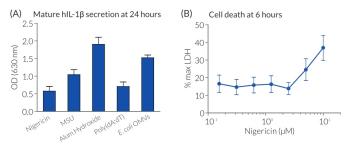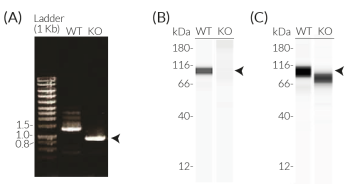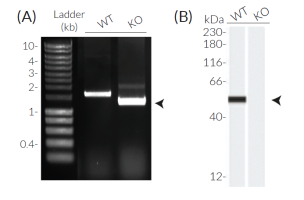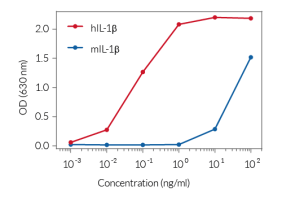THP1-Null2 Cells
-
Cat.code:
thp-nullz
- Documents
ABOUT
Positive control cell line for inflammasome studies
THP1-Null2 cells are derived from THP-1 human monocytic cells, the most commonly used model cell line for the study of inflammasome activation. Indeed, they express high levels of NLRP3, ASC, and pro-caspase-1 [1]. These cells produce IL-1β upon stimulation with canonical or non-canonical inflammasome inducers, such as Nigericin, MSU crystals, Alum Hydroxide, Poly(dA:dT), LPS, or E. coli outer membrane vesicles (OMVs). Moreover, they undergo pyroptotic cell death upon inflammasome activation.
THP1-Null2 cells are the positive control cell line for InvivoGen’s THP1-KO-ASC, THP1-KO-NLRP3, THP1-KO-CASP4, and THP1-KO-GSDMD cells.
These cells are resistant to Zeocin®.
For detecting and quantifying the release of mature human (h)IL-1β, InvivoGen provides HEK-Blue™ IL-1β sensor cells, which express an NF-κB-inducible SEAP reporter gene. QUANTI-Blue™ Solution allows rapid colorimetric detection and measure of SEAP activity by reading the optical density at 630-650 nm.
![]() Read our review on Inflammasome activation
Read our review on Inflammasome activation
References:
1. Schmid-Burgk, J.L et al., 2015. Caspase-4 mediates non-canonical activation of the NLRP3 inflammasome in human myeloid cells. Eur. J. Immunol. 45:2911.
Disclaimer: These cells are for internal research use only and are covered by a Limited Use License (See Terms and Conditions). Additional rights may be available.
SPECIFICATIONS
Specifications
Screening of inflammasome inducers
Complete RPMI 1640 (see TDS)
Verified using Plasmotest™
Each lot is functionally tested and validated.
CONTENTS
Contents
-
Product:THP1-Null2 Cells
-
Cat code:thp-nullz
-
Quantity:3-7 x 10^6 cells
- 1 ml of Zeocin® (100 mg/ml)
- 1 ml of Normocin™ (50 mg/ml)
Shipping & Storage
- Shipping method: Dry ice
- Liquid nitrogen vapor
- Upon receipt, store immediately in liquid nitrogen vapor. Do not store cell vials at -80°C.
Storage:
Caution:
Details
THP1-Null2 cells are suited for the study of inflammasome activation. The model of functional inflammasome formation is a two-step process of priming (step 1) followed by activation (step 2). Priming (i.e. with LPS) induces the production of pro-IL-1β, the immature form of IL-1β. Subsequent stimulation with inflammasome inducers, such as Nigericin or Alum Hydroxide, leads to caspase-1 activation and IL-1β maturation and secretion. Mature IL-1β can be detected by Western blot, ELISA, or a cell-based assay.
InvivoGen has developed a cellular assay to detect bioactive IL-1β using HEK-Blue™ IL-1β reporter cells. These cells feature the SEAP (secreted embryonic alkaline phosphatase) reporter gene under the control of an NF-kB-inducible promoter. They naturally express the IL-1β receptor (IL-1R), and all the proteins involved in the MyD88-dependent IL-1R signaling pathway that leads to NF-kB activation. Thus, upon IL-1β binding to IL-1R, a signaling cascade is initiated triggering NF-kB activation and the subsequent production of SEAP. Detection of SEAP in the supernatant of HEK-Blue™ IL-1β cells can be readily assessed using QUANTI-Blue™ Solution, a SEAP detection medium. QUANTI-Blue™ Solution turns blue in the presence of SEAP which can be easily quantified using a spectrophotometer.
DOCUMENTS
Documents
Technical Data Sheet
Validation Data Sheet
Safety Data Sheet
Certificate of analysis
Need a CoA ?








